Nature’s laws of survival demand that predators feed on their prey. A tiger chasing a deer, a desert fox scanning the desert floor for spiny-tailed lizards, dhole bringing down a sambar stag. All normal scenarios playing out in the wildscape. But the picture gets skewed when a creature born of human influence such as the domestic dog appears on the scene. From the massive Tibetan wild ass in the Himalayas to one of the heaviest flying birds in the world, the critically endangered Great Indian Bustard in central and western India, are all falling prey to feral dogs that have taken over wild habitats, both protected and unprotected. This is a gross aberration of the natural food web design. Co-evolution of humans and domestic dogs has now reached a critical juncture in history. With expanding human domination over land, domestic dogs too have penetrated every terrestrial surface and habitat, with unfortunate consequences. After domestic cats and rodents, domestic dogs rank third as world’s most damaging invasive mammalian predators.
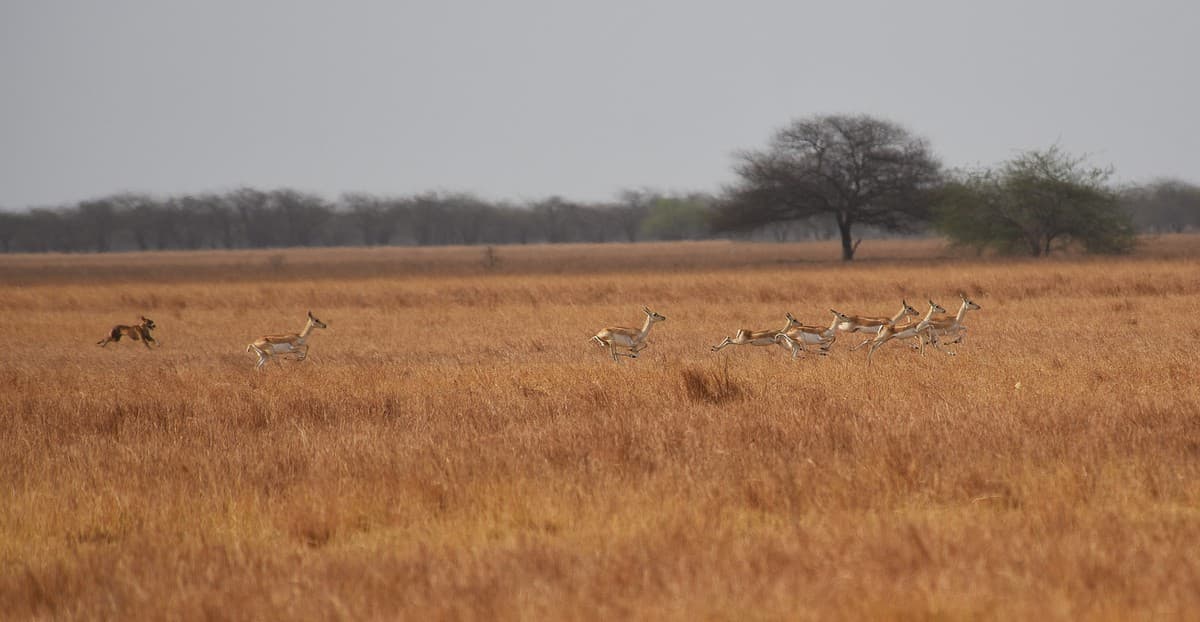
A free-ranging dog chases a herd of blackbucks in Velvadar National Park, Gujarat. Ungulates are often hunted and killed by feral dogs in India. Photo credit: Dr. Anish Andheria
Today, an estimated one billion domestic dogs are found globally and their impact on wild species the world over has been a matter of ever-growing concern. According to a 2017 study on ‘The global impacts of domestic dogs on threatened vertebrates’ published in Biological Conservation, about 188 wild species are currently threatened by free-ranging dogs worldwide. This list comprises mammals, birds, reptiles, and amphibians, of which nearly 30 species are critically endangered. But the impact of feral dogs on wildlife is not restricted to predation alone. The impacts surpass predation and even manifest as disturbance, transmission of diseases to other species including humans, competition to other predators, and interbreeding with wild canid species.
How are domestic dogs different from natural predators?
About 15,000 years ago, the slightly bolder among wolves (Canis lupus) began to venture closer to nomadic human encampments set up by hunter-gatherers, to scavenge for food. Soon, humans recognised the usefulness of having these wolves around for protection and preemptive warnings against incoming dangers. Eventually, this interaction between humans and wolves deepened and took a social and cultural turn. Natural selection coupled with human interventions singled out such tamer wolf populations. Soon, artificial selection was set in motion. For several reasons that humans found them to be beneficial and appealing, they domesticated the animals, selectively bred them till the domestic versions of dogs no longer resembled any of their wild counterparts, and these special lineages thrived in the company of humans. Today, domestic dogs (Canis familiaris) have near-global distribution and nearly 400 recognised breeds exist.
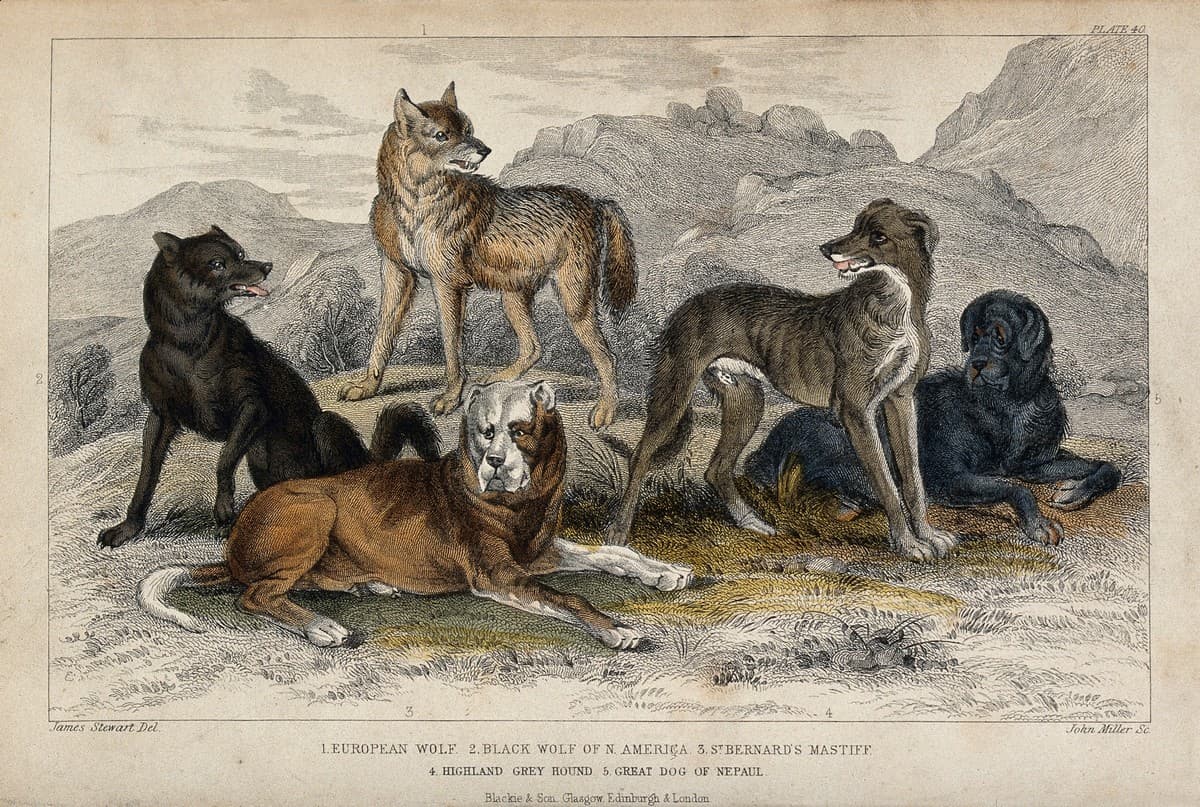
The domestic dog (Canis familiaris) evolved from wolves (Canis lupus) through taming, domestication, and selective breeding by humans over the past ~15,000 years. Credit: Wellcome Images/Wikimedia Commons
Natural selection pressures have had almost nothing to do with the unprecedented rise and spread of the domestic dog. The evolution of domestic dogs can be wholly attributed to humans. They are either entirely or partially dependent on people for survival and have no ecological role to play in any terrestrial ecosystem. They are not part of the natural food chain. But the feral and free-ranging dogs have established themselves as dangerous predators whose pack-hunting skills inherited from the wolf ancestors are still more or less intact. In their feral avatar, domestic dogs reign as effective pack hunters capable of bringing down animals much larger in body size than themselves, including large carnivores. Today, dogs are among the most widespread carnivores as well as the most abundant.
Free-ranging domestic dogs are hardy, adaptable, and highly flexible with their diet. They can survive on stale food scraps left by humans and even hunt and feed on wild animals. This makes them extremely dangerous to native wildlife.
As human population rises, and more natural habitats get usurped by people and urbanised, more widespread the dogs become, thanks largely to parallel increase in waste and conducive environment that sustains dogs. This is further dissolving the distance between free-ranging dogs and wildlife, making numerous wild species more vulnerable to predatory attacks by dogs.
India’s Wildlife Under Severe Threat from Feral Dogs
India is home to the fourth-largest population of dogs in the world. With the nation carrying a staggering population of nearly 60 million domestic dogs, of which nearly 35 million are stray or free-ranging (living partly or entirely on their own), the pressure on already struggling wildlife is dramatically increasing. An estimated 80 wild species in India suffer frequent attacks by domestic/feral dogs, nearly half of which are threatened as per the IUCN Red List.
Even India’s Protected Areas such as national parks, core areas of tiger reserves and wildlife sanctuaries are not immune to the invasion of feral dogs. As per a study that assessed the impacts of dogs on India’s native species, nearly 48 percent of the reported feral dog attacks on wildlife were found to be in and around Protected Areas. Large-bodied ungulates and carnivores, as well as reptiles, amphibians, ground birds, and small mammals are frequently preyed upon.
Rajasthan’s grasslands and deserts are under siege by free-ranging dogs. Ungulates like the chinkara, blackbuck, nilgai, and among reptiles the spiny-tailed lizard and monitor lizard, are vulnerable to dog attacks. “Free-ranging dogs are responsible for more killings of chinkara (Indian gazelle), the state animal of Rajasthan, than any other agent,” wildlife biologist, Sumit Dookia told Down To Earth. Less than 150 Great Indian Bustards remain in the wild, with a small population surviving in Rajasthan. But, the dog menace could prove to be the last nail in the coffin for this bird, pushing the species to the brink.
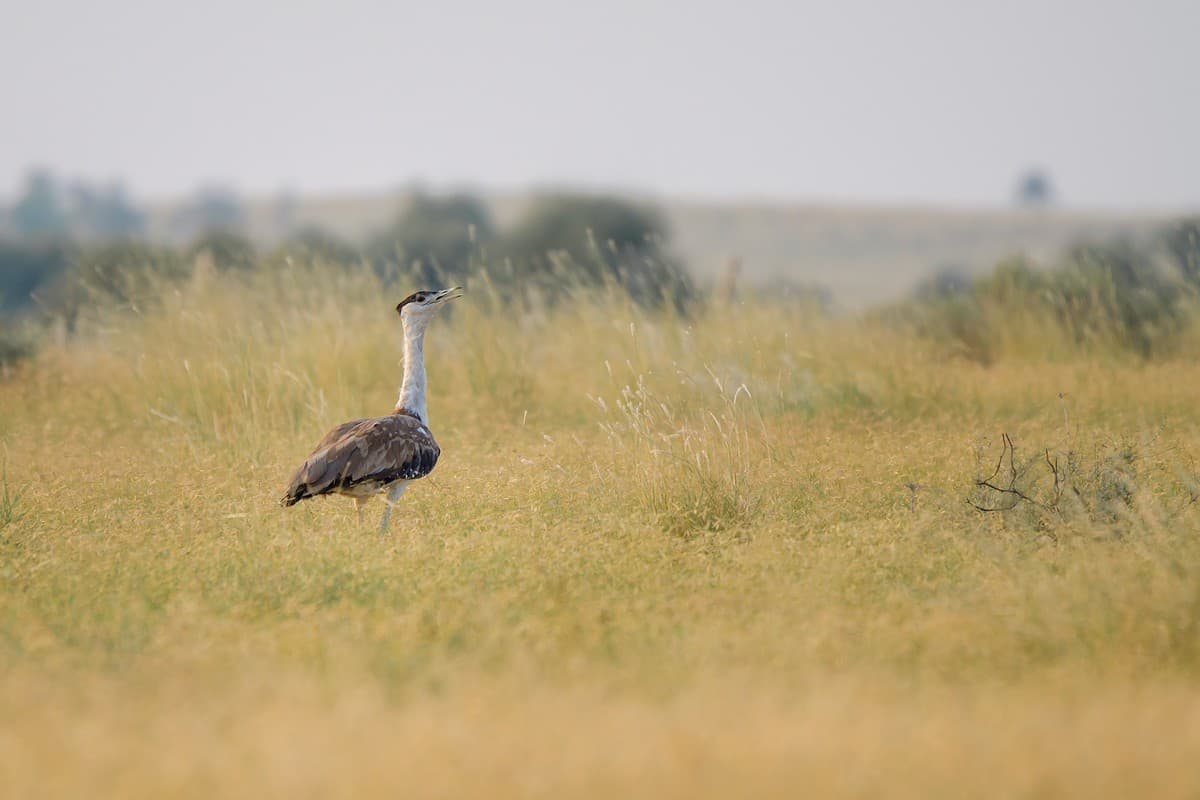
Populations of endangered species such as the Great Indian Bustard are gravely threatened by free-ranging dogs affecting their population recovery and conservation efforts. Photo credit: SaurabhSawant/ CC BY-SA 4.0
In the northeastern state of Sikkim, the threat of free-ranging dogs to the wildlife and people has exacerbated in the recent years due to improper waste management and open defecation. Animals like yak are increasingly targeted by dog packs. Even Tibetan wolves have begun to avoid areas dominated by domestic dogs according to a UNDP India report.
The state bird of Ladakh, the Black-necked Crane, is another near threatened bird whose population is at severe risk from dogs. According to the Down To Earth report, the free-ranging dogs have affected the breeding success of the Black-necked Crane. There have been reports of dogs feeding on the eggs and hatchlings of this and other birds in the Changthang Wildlife Sanctuary in Ladakh, where about 3,500 free-roaming dogs have been counted.
Alarm bells have started ringing in Haryana too. Between 2016 and 2020, the Haryana Forest Department reported 361 blackbucks, 1641 nilgai, 29 chinkara, 25 peafowl and 35 monkey kills by free-ranging dogs, all from Hisar Division. Except for Kalesar National Park, Haryana is devoid of any large carnivores. Now dogs have filled this vacant niche and have been categorised as the only major predator in the state.
The threat of transmission of diseases such as canine distemper, rabies, and sarcoptic mange from domestic dogs to wildlife, is an ever-looming threat. In 2020, various diseases including canine distemper and rabies, claimed the lives of several Asiatic lions in Gujarat, where the world’s last remaining Asiatic lion population persists. In September 2018, an infection from the canine distemper virus (CDV) was detected in the Asiatic lion population in Gir, Gujarat. Since the disease is more prevalent in dog populations, experts suspect that the free-ranging dogs could have been the source of the virus.
Interestingly, it was the critical decline in vulture populations in India, observed between 1992 and 2007, that led to dramatic rise of feral dogs in the country. The silent killer of the vultures, it was found after much investigation by experts from various nations, was the non-steroidal anti-inflammatory drug called Diclofenac which was being widely used to treat cattle in India and other neighbouring countries. Vultures, being obligate scavengers would feed on the cattle carcasses, ingesting the Diclofenac in the process, leading to fatal renal failure and gout. The important role of the scavengers in an ecosystem, as well as in the human society, became clear when with no vultures left to feed on the thousands of dead cattle, they now lay strewn across rural landscapes. One major problem that arose, was the proliferation of the dog population, which saw an increase of an estimated 5.5 million in India.
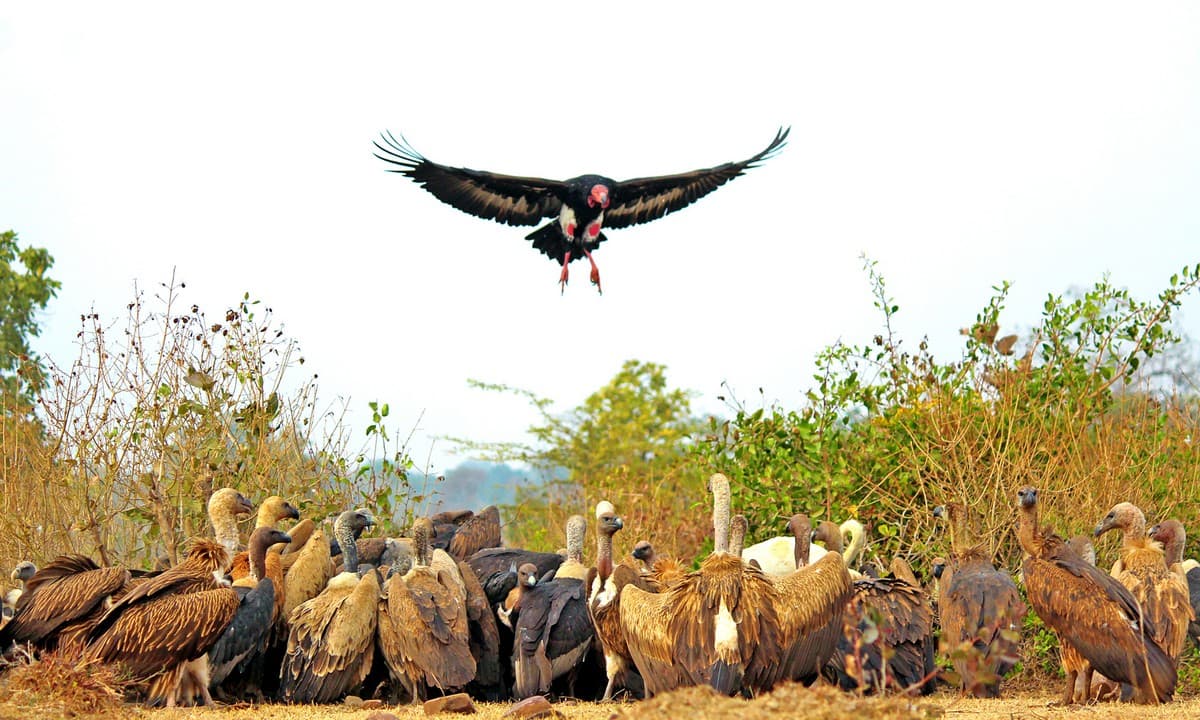
A severe decline in vulture populations in India has been touted as being one of the reasons for the exponential rise in domestic dog population. Photo credit: Arindam Aditya/C BY-SA 4.0
Today, ironically, vulture conservation efforts in India are being partly impeded by the feral dogs who are known to chase vultures away from carcasses. With such stiff competition over food, vulture populations are finding it increasingly difficult to recover.
Time to Reconcile India’s Animal Welfare Laws with its Wildlife Protection Laws
Solving India’s feral dog crisis is no straightforward matter, but that which must be urgently dealt with. A holistic, humane, scientific, integrated and a sustained approach to implement effective dog population control measures include responsible dog ownership, control of open defecation, and proper waste management, especially in and around conservation areas.
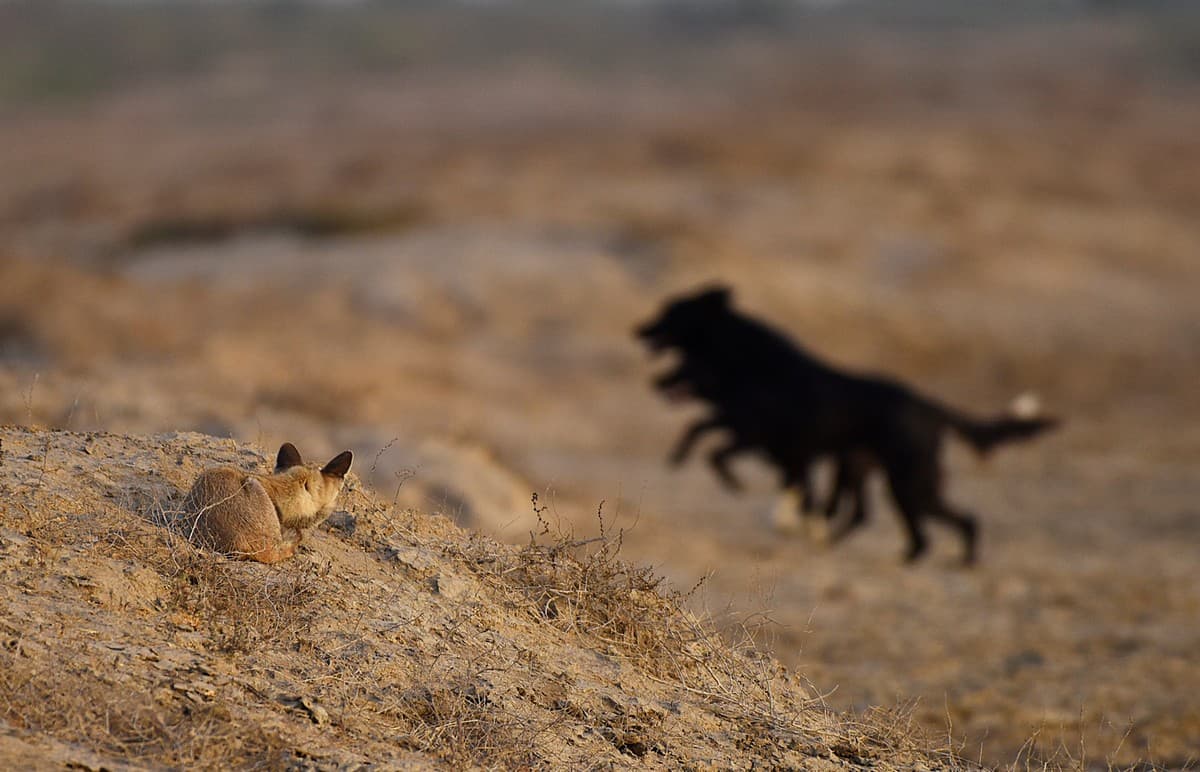
A desert fox hides from a pack of feral dogs in the Little Rann of Kutch. Feral dogs are known to attack predator species in the wild, compete for food resources, interbreed with other canid species, and even alter their behaviour. Photo credit: Dr. Anish Andheria
Strangely, India’s wildlife protection laws and animal welfare laws are at a legislative crossroads when it comes to dealing with the unsustainable free-ranging dog crisis. In India, the case of free-ranging dogs is a complex issue that invokes animal welfare as well as conservation interventions. Some conservationists in India opine that the country’s dog management policy as devised by the Animal Welfare Board of India, is unscientific and is not helping the cause of wildlife. Because the rules laid down by the body do not make an exception in its blanket ban on relocation of dogs post sterilisation, from wildlife sanctuaries, national parks, other Protected Areas and eco-sensitive regions, it continues to pose a threat to wildlife. At the same time, the Wild Life (Protection) Act, 1972, is silent on the treatment of free-ranging dogs within Protected Areas. The state Forest Departments and other conservation actors are thus constrained from removing invasive, free-ranging dogs from important wildlife habitats.
The Animal Birth Control (ABC) Rules laid down by the Animal Welfare Board of India (AWBI) in 2001 states that the “relocation of dogs is not permissible” and that “it is imperative that dogs are released back to the exact location from where they were picked up”, because “sterilized dogs have to remain in their original areas.” It goes on to claim that “this results in a reduction in the number of free-ranging dogs predating on endangered wildlife species, and thus promotes wildlife preservation.” Sterilisation programmes have not been successful anywhere in the world, and not in India either. The AWBI is reported to have spent INR 22.5 crore on dog sterilisation programmes between 2008-2018. Slow results from sterilisation programmes have not proven to be an adequate measure in preventing the loss of wildlife due to free-ranging dogs.
On July 31, 2022, the Ministry of Fisheries, Animal Husbandry and Dairying (MFAHD) released the Draft Animal Birth Control Rules, 2022, that prescribes an extensive framework for population control, immunisation, and feeding of street dogs. While the draft addresses the public safety and health concerns posed by the free-ranging dogs, the Rules are next to oblivious to the dire threat that the dogs pose to native wildlife.
Compromising protection of wildlife threatens our environmental and ecological security. The sanctity of the Protected Areas and other ecologically important areas needs to be maintained at all costs. It is then vital that logical measures be taken to reduce the impact of free-ranging dogs in and around such areas in order to protect wildlife populations. This mammoth, complex task can only be achieved through seamless inter-agency cooperation and will, and increased awareness.
Multiple wildlife organisations including the Wildlife Conservation Trust (WCT), and several individuals have written to the MFAHD with comments on the Draft, and many have even filed petitions with respect to management of free-ranging dogs in wildlife habitats. They rightfully demand that an exception be made in the ABC Rules to allow for removal of free-ranging dogs from sensitive wildlife habitats in order to curb the varied threats posed to innumerable wild animals in the form of predation, disease transmission, unnatural competition, and hybridisation by free-ranging dogs.
About the author: Purva Variyar is a conservationist, science communicator and conservation writer. She works with the Wildlife Conservation Trust and has previously worked with Sanctuary Nature Foundation and The Gerry Martin Project.
Disclaimer: The author is associated with Wildlife Conservation Trust. The views and opinions expressed in the article are her own and do not necessarily reflect the views and opinions of Wildlife Conservation Trust.
Your donations support our on-ground operations, helping us meet our conservation goals.
Related Links
- Man’s best friend, wildlife’s NEW foe!
- Weird Connections
- Roofed turtles, iguanas, ball pythons as pets is bringing Indians false sense of glamour
